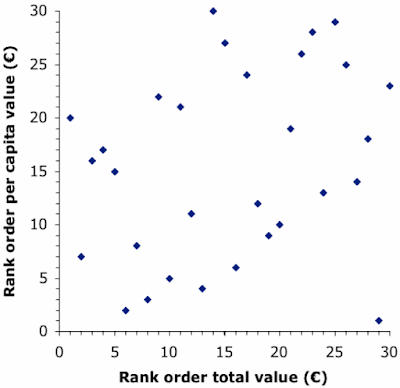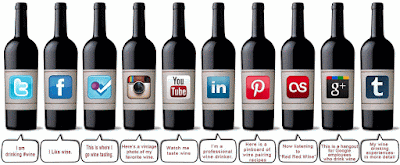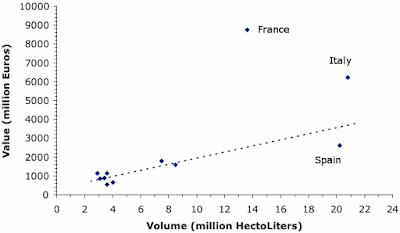Over the past fortnight, a number of apparently controversial issues have arisen in the wine industry. However, it seems to me that in several cases the combatants are talking at cross purposes; and the media are not helping the situation. So, I will discuss three of them here.
BordeauxLet's start with the kerfuffle in Saint Emilion, in which two of the Grand Cru Classé A estates (Château Cheval-Blanc and Château Ausone) are withdrawing from the upcoming (2022) revised classification process:
Bordeaux giants quit the classification system.
These estates have officially objected to the criteria being used for the revision, claiming that "the areas for evaluation went too far beyond what we considered fundamental". Naturally, they have also claimed that: "It is not that we feel that we are above the classification at all, or that we don't need it".
My immediate response, along with some other people, is: "I wasn't born yesterday". Let us have a look at the listed criteria that the two estates list as important, along with a list of those to be used for the re-classification. We can align them this way, with the estate criteria on the left and the new criteria on the right:
the terroir
the wine
the history
|
terroir analysis
tastings (of the last 10-15 vintages)
sales
visitor experience
press coverage
social media presence
|
When looked at like this, it is pretty obvious, isn't it? The criterion that the estates insist is missing from the new criteria is their exalted history, whereas the evaluation by the Institut National de l'Origine et de la Qualité will include what is happening today, instead.
Now, okay, the wine industry is well-known for
resistance to high-tech. Many wine producers only take reservations by phone, for example, and some
don’t use social media at all.
However, these two estates seem to be living in the wrong century; and they will have to face up to it eventually. There is, of course, also the more basic question of
whether we even need classifications of wine estates, in the first place.
Croatia versus ProseccoThe Italian DOC and DOCG wine region of Prosecco seems to like litigation. A while ago, they lost a very long-standing argument with the Australians, who insisted that the name “Prosecco” has always referred to a grape variety, as well as to a geographical region. The Italians tried to insist that the grape should be called “Glera”, leaving the “Prosecco” name untainted as a Geographical Indication. They lost, although
the Australians did agree to call their Glera-based wines “Australian Prosecco”, just to be clear.
The Italians are now after the Croatians, again, who are much nearer to them, being just across the water:
Prosecco wars: Italy protests Croatia’s bid for special status for its prošek wine.
The Croatians have submitted yet another application for special European Union recognition of their dessert wine, called “prošek”. In response, the Italian members of the European Parliament have protested to the European Commission. Their argument is this:
When Croatians say “prošek”, they mean a centuries-old sweet, dessert wine made near the Adriatic coast from the grapes that have been dried in the sun in order to concentrate the sugar in their juice. When Italians say “prosecco”, they mean the sparkling wine, produced exclusively in northern Italy, made from the glera grape variety, often blended with other white wine varieties.
Clearly, the two words do sound alike; and this obviously arises from geographical proximity. Italian is a Romance language, while Croatian is a Slavic language (technically, South Slavic), and thus the two words do not descend from a single ancestral word. This is an example of what we call evolutionary convergence.
Given that the two wines under discussion have little in common stylistically, it is only the similarity of name that is being disputed. What are the Italians trying to claim: that their customers cannot tell a sweet Croatian wine from a bubbly Italian one? Perhaps Prosecco's customers cannot tell any of these apart, either:
- Proseč (a town in the Pardubice region of Czechia)
- Prosec (a prescription medicine that is used for the short-term treatment of duodenal ulcers)
- any one of the Procedural Security companies that exist worldwide, who use the same Prosec abbreviation.
We need to get serious here. The stealing of words for commercial purposes is one thing, to be deplored; but historical convergence of words due to geographical proximity is another thing altogether. We are going to have centuries of litigation if we start deploring the latter. Sadly, the betting seems to be that the
Croatians will lose, anyway.
Shampanskoye vs. ChampagneThis is being treated as the biggest scandal of the past fortnight. The Russian government has deemed it time to start regulating what can be written in Russian on the back label of a bottle of sparkling wine, in Russia:
Russia's storm in a champagne flute. This should surprise no-one.
However, the wine industry in Europe, in particular, has reacted in what seems to be a rather extreme manner:
In amongst all of this media hype, there has been at least one word of common sense:
The latter article points out that the new Russian law applies only to the Cyrillic script on the back label of the bottles, not what is written in Latin script on the front label. This means that the front label of imported sparkling wines does not have to change, and can say “Champagne”, “Prosecco” or “Cava”, as the case may be. The back label, however, cannot say any of these equivalents:
Шампанское (Shampanskoye or Champanskoïé)
Просекко
Кава вино
but must instead say:
Игристое вино (Sparkling wine)
This makes it difficult to see what the fuss is about. Perhaps it comes from people who are not used to having two languages on their wine labels? Oddly, these people seem to be blaming Vladimir Putin personally for this situation, rather than discussing broader governmental motives. More interestingly, it
has been pointed out that the situation regarding Champagne and Switzerland is really rather similar.
Mind you, the Comité Champagne Interprofessional Champagne (CIVC) is also willing to object to other products that actually do contain champagne. For example, the recent resolution concerning the Aldi Champagne Sorbet, which contains 12% champagne wine, was in favor of the objectors (the CIVC), who claimed that use of their unique wine did not give the sorbet any fundamental characteristics (
Aldi’s champagne sorbet goes sour).
On the other hand, the Organisation Internationale de la Vigne et du Vin (OIV) has
now adopted Russian as its sixth official language, which “will enable the Russian-speaking community to better understand and appropriate the international standards and practices that the OIV has adopted to improve the conditions of production and marketing of vine and wine products.” Thus sounds eminently sensible; and it involves no litigation at all.
ConclusionPerhaps the current pandemic has had more affects on the wine industry than people have realized. All of this “social distancing” might have been taken metaphorically as well as literally, and people are now making trouble out of boredom. If so, then the sooner you all get vaccinated (so far, USA: 48%; Sweden 57%), then the sooner you can
take your masks off, and start being social to each other again. Do not make an official storm in every teacup you can see.












